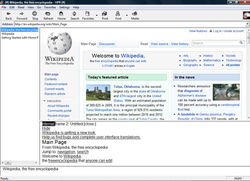| | |
 Home Page Reader 3.0 rendering Wikipedia. | |
| Developer(s) | IBM Special System Needs (SNS) |
|---|---|
| Final release | 3.04 [1] / 2005 |
| Operating system | Windows 95/98/NT |
| Platform | Windows |
| Available in | English, French, German, Italian, Japanese, and Spanish [2] |
| Type | Screen Reader |
| Website | Homepage (Archive.org) |
Home Page Reader (Hpr) was a computer program, a self-voicing web browser designed for people who are blind. It was developed by IBM from the work of Chieko Asakawa at IBM Japan.
Contents
The screen reader met World Wide Web Consortium (W3C) HTML 4.01 specifications, Web Content Accessibility Guidelines 1.0 and User Agent Accessibility Guidelines 1.0. [3]
In 2006, it was announced on the Hpr mailing list that IBM does not have plans for any further updates of HPR and the software was subsequently withdrawn from sale by IBM in December 2006. [4] IBM has given code to be used as a Firefox extension.[ citation needed ]
The program also had a peer-support mailing list. [5] [note 1]